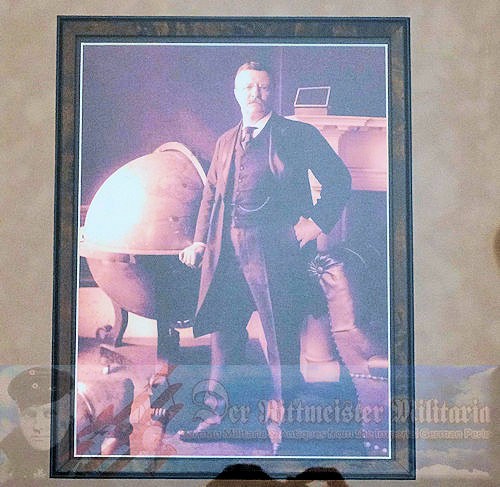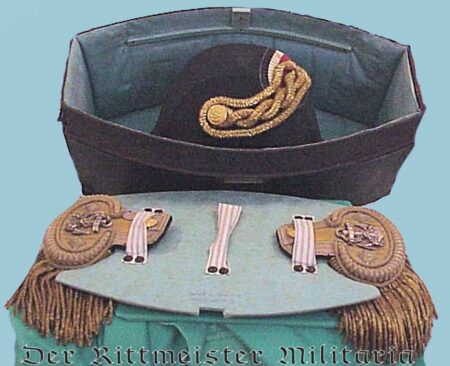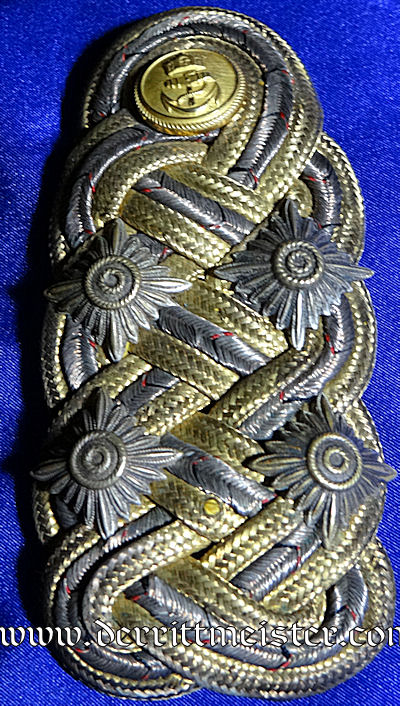Description
CUSTOM-FRAMED NAVAL ADMIRAL PATENT & PHOTOGRAPH SIGNED BY PRESIDENT THEODORE ROOSEVELT.
Theodore Roosevelt is among the most revered United States Presidents. He served in many governmental roles, such as the Assistant Secretary of the Navy in 1897. When war broke out with Spain in 1898, he resigned and formed the Rough Riders in concert with Col. Leonard Wood. [Wood had won the USA’s Medal of Honor for action against the Apaches, and later served as the U.S. Army’s Chief of Staff]. The Rough Riders were (also known as the 1st U.S. Volunteer Cavalry or 1.U.S.V.). During the campaign Wood, its founding regimental commander, assumed the Brigade’s command after its assigned commander fell ill. Roosevelt then was promoted to colonel, took command of the regiment, then led it on the famous charge up San Juan Hill.
[PLEASE NOTE the following side notes: the 10th U.S. Cavalry regiment was a flanking regiment consisting of African-American troopers under white officers. Also known as “Buffalo Soldiers,” they had fought Indians in the American West, with John J. (“Black Jack”) Pershing as one of their officers. Pershing later commanded U.S. Army troops in France during WW I. Theodore Roosevelt finally received the Medal of Honor in 2001 from President Bill Clinton for his actions during the Spanish-American War. Roosevelt had been awarded the Nobel Peace Prize in 1906. Both his Medal of Honor and Nobel Peace Prize are enshrined in the White House’s “Roosevelt Room.” Finally, Roosevelt’s son, Brigadier General Theodore (Ted) Roosevelt, Jr. (1887-1944) received the Medal of Honor for his actions during the 6 June 1944 Invasion of Normandy. He went ashore with the first wave of American troops onto Utah Beach. Just thirty-six days later he died of a heart attack].
Following the Spanish-American War’s end, Roosevelt returned to New York and became its Governor. He was elected Vice President to William McKinley when the latter ran for his second term. McKinley won the election but was assassinated in 1901, resulting in Roosevelt becoming the 26th U.S. President. He filled out the balance of McKinley’s second term, then won a full term of his own in 1904. Roosevelt was a reformer who pushed for change and became well known for his battles with monopolies formed by the U.S. banking, steel, and oil companies. He gained the nickname of “Monopoly Buster” for these hard-fought bitter battles.
Roosevelt was also a proponent of making the U.S. a world power. At the time, the U.S. and Japan were both emerging powers of increasing influence when compared to Europe’s powerhouses Great Britain, and Germany, followed by France and Russia. Following the 1898 defeat of Spain, the U.S. had acquired foreign possessions in Asia. Roosevelt now implemented his “Big Stick” diplomacy in order to project the USA’s naval and political power. To that end, Roosevelt sent the U.S. Navy’s strongest ships (the “Big Stick”) on an extended worldwide cruise. The fleet (essentially the Atlantic Squadron), went on what turned into a fourteen-month, 43,000 nautical mile voyage, with some 14,000 American sailors aboard sixteen battleships. This became known as the Great White Fleet (since the ships had been painted in their normal white Summer livery with gilt, red, white, and blue accents at their bows). They were a pre-dreadnaught variety, but a powerful fleet nonetheless.
The fleet was assembled in December 1907 at Hampton Roads, Virginia, then proceeded to the West Coast for refitting before launching the Asian portion of the journey. The original commander of the fleet was Rear Admiral Robley D. Evans. Due to ill health, he was replaced on the West Coast by Rear Admiral Charles S. Perry. The fleet was broken down into four Divisions of four ships each. The commander of the 3rd Division, Captain Nathan E. (Kossuth) Niles (1849-1913), sailed aboard the U.S.S. Louisiana (BB 19). [The U.S.S. Louisiana was one of the fleet’s more modern ships and part of the Connecticut Battleship Class (the U.S.S. Connecticut was the Great White Fleet’s flagship). The U.S.S. Louisiana was commissioned in 1906 and stayed active until 1920, when she was struck from the list of Navy ships. The Louisiana was scrapped in 1923].
Since the U.S.S. Louisiana was one of the fleet’s modern ships, she was commanded by one of the Navy’s more experienced captains, the acting Commodore of the 3rd Division. Niles first joined the Union Army (yes, Army) during the Civil War in 1864 as a member of the 142nd Illinois Volunteer Infantry Regiment. The following year he was posted to the U.S. Naval Academy in Annapolis, Maryland as a cadet. His naval career extended from 1865 until 1911, when he reached the mandatory age of retirement. He was buried at Arlington National cemetery following a fatal heart attack at a New York book store in 1913.
The Great White Fleet’s cruise consisted of four legs. Earlier legs had included stops in the Caribbean, South America, Australia, and Japan. The cruise was intended to particularly impress Japan that the U.S. was a major world player with an impressive naval force that should be treated respectfully in the Pacific. The fleet made port at Yokohama where it was received hospitably. The fourth and final leg began at in Manila at the USA’s Subic Bay naval base. The fleet arrived on 7 November 1908, then departed on 1 December 1908. It made port in Ceylon, Egypt (exiting through the Suez Canal), then Gibraltar, before returning to Hampton Roads. During the stop in Manila, Niles received word that President Roosevelt had promoted him to Rear Admiral.
It is THIS very promotion document (termed a “patent” in Imperial Germany) we are offering today. Such documents were extremely ornate during that period. The document was prepared on 12 November 1908. Niles’ actual promotion from Captain to Rear Admiral, however, occurred on 27 November 1908, just days before the fleet began its homeward leg. Thus, before the fleet’s departure on 1 December, Niles was confirmed to Flag rank. The actual document was waiting for him upon his return to Hampton Roads.
The patent measures 15″ x 17.” It was folded at some point, and the fold remains visible. That said, the document is in excellent condition with no foxing, tears, rips, or etc. It is as handsome as it was more than one-hundred-years ago when it was issued and signed by Theodore Roosevelt. Roosevelt’s name appears atop the preprinted document in large letters. The document states that Niles was promoted to Rear Admiral effective 12 November 1908. Theodore Roosevelt’s very bold signature appears at the document’s bottom. The document is countersigned by the Secretary of the Navy, Victor H. Metcalf (1853-1936). He served in that capacity from 1906 through most of 1908. Metcalf officially retired effective 1 December 1908, so this was one of his final acts as Secretary of the Navy. The document is also countersigned by the Registrar of the United States. A blue foil seal bearing the U.S. Navy’s Coat-of-Arms appears on the document’s lower left side above the latter two signatures.
Flanking the document is one of Theodore Roosevelt’s most famous photographs. He stands with his hand on a massive world globe exuding a world leader’s stern confidence. His policies placed the USA firmly on the path to political and military dominance. With the election of Theodore’s cousin, Franklin D. Roosevelt, in 1932, the U.S. continued its rise to the pinnacle of world leadership by the conclusion of WW II.
[This document was framed for my personal enjoyment, so we spared no expense on the project. Due to the frame’s size and the level of materials that I requested, it cost me nearly $1,000 to complete. I wanted to pay homage to the man I consider one of the greatest American Presidents. I felt that such an incredible piece of American history deserved nothing but the BEST. We accomplished the feat at a premiere framer in our area after spending more than hour selecting every detail of what you see presented in the accompanying photographs].
The overall frame measures a whopping 28″ x 35.” It requires a good-sized wall to properly display it! The frame’s molding is made of richly sumptuous burlwood instead of the gilt that often appears on high-end framing jobs. We wanted to evoke the ambiance one might have expected to find in the Captain’s cabin aboard the U.S.S. Louisiana. When properly polished, the burlwood simply glows the way a fine cigar does when lit and enjoyed.
The promotion document and Teddy Roosevelt’s photograph are double-matted inside two separate windows within the frame. The double-matte’s top layer is made of pale beige suede material imprinted with a slightly darker brown pattern that mimics that on the burlwood frame. As previously noted, the promotion patent measures an impressive 15″ x 17.” Roosevelt’s photograph measures 7″ x 10.” Each item is once more outlined with more burlwood trimmed on all sides with thin strips of elegant, black wood. Often matting is just colored cardboard, but that simply would NOT do for this presentation. When he finished the project, the framer begged me to allow him to display it in his store!
I have enjoyed this piece for many years. I was especially proud in 2008 when the 100th anniversary of the document’s signing came to pass. I am including some copies of photographs that will enhance the document’s history, which I have described below.
1. A group photograph of Captain Niles and other senior officers from the cruise of the Great White Fleet in their full-dress uniforms, complete with their fore-and-aft caps (Zweispitzen).
2. Another photograph of several Great White Fleet officers. They are posed in regular-duty uniforms and headdresses. It provides a closer look Captain Niles.
3. A photograph of a large group of officers at a garden tea party, including Captain Niles, held in Tokyo in 1908. A Japanese officer is in the front row.
4. A photograph of the U.S.S. Louisiana (BB19) as she appeared on the Great White Fleet’s cruise.
5. A photograph of Secretary of the Navy Victor Metcalf, whose signature appears on the document along with those from Teddy Roosevelt and the U.S. Registrar.
This magnificent presentation is ready for a new owner to enjoy. [Due to its size and weight, we will have it professionally packed in a custom carton to ensure its safe arrival to its new owner. Shipping costs will be quoted when you are ready to order].









